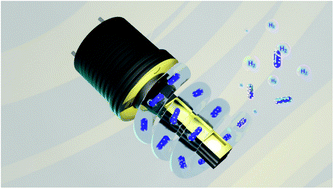Flow synthesis of photocatalytic semiconductor–metal hybrid nanocrystals†
Abstract
Semiconductor–metal hybrid nanostructures are promising materials for photocatalytic applications, providing high efficiencies compared to their composing counterparts. So far, the synthesis of such hybrid nanoparticles was limited to batch reactors, achieving tunability while demonstrating how each of the nanocrystals’ characteristics affects photocatalytic performances. Yet, new methodologies should be established to increase the synthetic yield while maintaining high control over the resulting structures. Herein, scalable advanced flow techniques are introduced, yielding ZnSe–metal hybrid nanoparticles either in a thermal growth or photo-induced growth regime. Firstly, thermal gold growth in the flow reactor is achieved with good control over the metal tip size and the nanoparticle morphology. We address the dependence of the reaction on temperature, the precursor to nanorod molar ratios, and additional parameters. Additionally, light-induced growth by the flow reactor is demonstrated for platinum clusters. The quality of the resulting hybrids is directly demonstrated by their functionality in photocatalytic hydrogen generation by water reduction, displaying enhanced activity compared to bare ZnSe nanorods. The fairly straightforward adaptation of such powerful flow-reaction techniques to scale-up photocatalytic hybrid nanoparticle syntheses takes them one step forwards towards the realization of their potential in real-life application scenarios.



 Please wait while we load your content...
Please wait while we load your content...